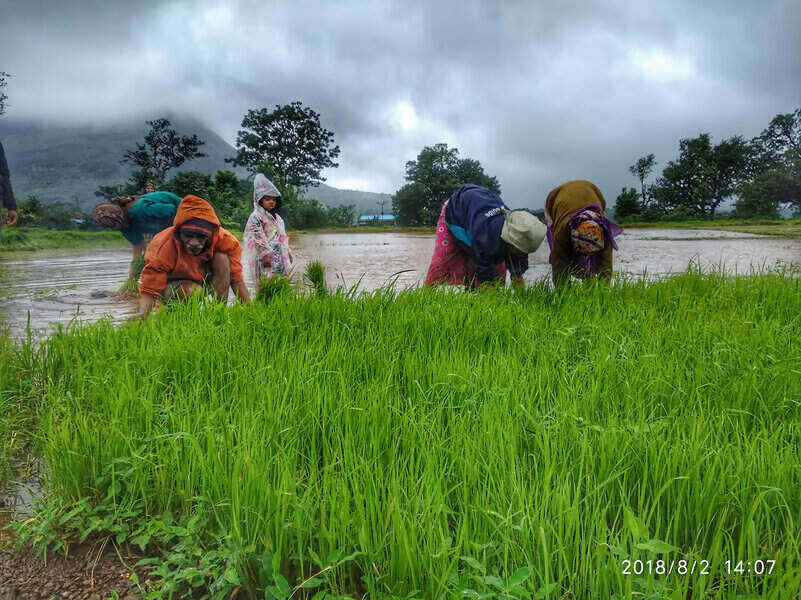How Adivasi Villagers Saved Sahyadri Black Rice

In the Sahyadri hills, Adivasi Mahadev Koli farmers revive ancient rice strains like Rani 98, amidst climate challenges and the loss of 1,04,000 rice varieties since the 1970s Green Revolution. Transitioning from hybrids back to heirloom grains, they prioritize taste and nutrition over yield, rekindling local traditions and sustainability in Maharashtra’s agricultural landscape.
On the scenic hilltop of Harishchandragad, the freshly sowed green strands of rice saplings stand out stunningly in the fertile black soil and the overcast grey skies of the Sahyadri hill range. With the onset of monsoon, Yashoda and her husband Sanjay Dhindale are in the middle of the sowing season in the Sheerepunje Khurd village. In the neighbouring twin village Sheerepunje Budruk, another 35 farmers are hard at work, their backs bent downwards, sowing over 500 varieties of native rice breeds.
The farmers of Sahyadri, belonging to the Adivasi Mahadev Koli tribe, are not just growing rice for themselves, but are also part of an aspiring conservationist movement that aims to re-establish the cultivation of heirloom grains, many of which have disappeared or are at risk of getting lost.
Across India, thousands of Indigenous rice strains have disappeared since the Green Revolution in the 1970s owing to increasing dependence upon hybrid seeds and the rapid occurrence of climate change. According to one estimate, more than 1,04,000 types of rice strains have been lost permanently and only 6,000 of the older varieties survive.
In Maharashtra too, the effects of climate change have caused the disappearance of hundreds of varieties. The tribes living in the rocky laterite plateau range used to grow a variety of Indigenous rice strains like Kalbhaat, Rani 98, Warangal, Raybhog and Komod, many of which are flood-resistant, pest-resistant and highly nutritious. These varieties almost disappeared as farmers transitioned towards high-yield, hybrid rice seeds.
The Dhindale family of five is back to cultivating their 2.5-acre land with the Rani 98 strain, a native rice variety whose short yellowish grains are rich in iron, and only grow on the Sahyadri hill slopes. “We’ve always eaten only the 98 variety. It is very delicious and tastes different than the rice sold in the shops,” says Yashoda. “Unless we eat our meals with this rice, our bodies don’t feel nourished. We don’t feel our stomach is full,” adds Sanjay sheepishly, pausing in the middle of the sowing season.
Around 2010, the Dhindale family, like other farmers around the region, stopped using native seeds and shifted towards hybrid cultivation because of high yield produce and higher selling rates in the market.
“We got attracted to the sarkari rice strains. There was no market for the deshi varieties which we could sell for Rs 12-Rs 14/kg, whereas sarkari rice rates commanded up to Rs 26/kg,” says Navnath Dhindle, a young farmer whose family exclusively cultivates the Kalbhaat or Sahyadri black. Highly aromatic and known for its nutritious value, Kalbhaat is virtually the king rice of Sahyadris as it is widely cultivated and known for its medicinal properties. Villagers consume its scratch water during fever and stomach ache as it is easy to digest and it is often given to lactating mothers and infants as their first solid meal.
The farmers soon realised the hybrid seeds were not pest-resistant and required heavy pesticides and ground fertilisers. They now had to spend double the money on cultivation than they would on the traditional farming of native varieties. Moreover, their two-time rice meals didn’t taste the same, they said.
Shailesh Awate, the co-founder of OOO farms and an avid trekker of Harishchandragad hill fort, began noticing the difference in the taste of rice served at the make-shift food tents. He had an unforgettable simple meal of matki usal and bhaat (pulses and rice) at the top of the hill in 2012 which made him pursue the origins of rice.
“It was an outstanding variety of rice. The smell and the taste were so different to the rice I had eaten anywhere in India,” he said about the Kalbhat variety. A few years later, when he returned to trek, the meal was not the same. “The villager told me the new rice variety was better as it produced a lot, but I didn’t find anything different in its taste this time,” he said.
Through conversations with local villagers, Awate learned the difference between the two meals was not just induced by food nostalgia but by native and hybrid rice grains. Many old farmers complained that the new seeds were destroying their land and making them bankrupt as it required a high use of fertilisers.
Source Link: https://www.outlookindia.com/national/how-adivasi-villagers-saved-sahyadri-black-rice














